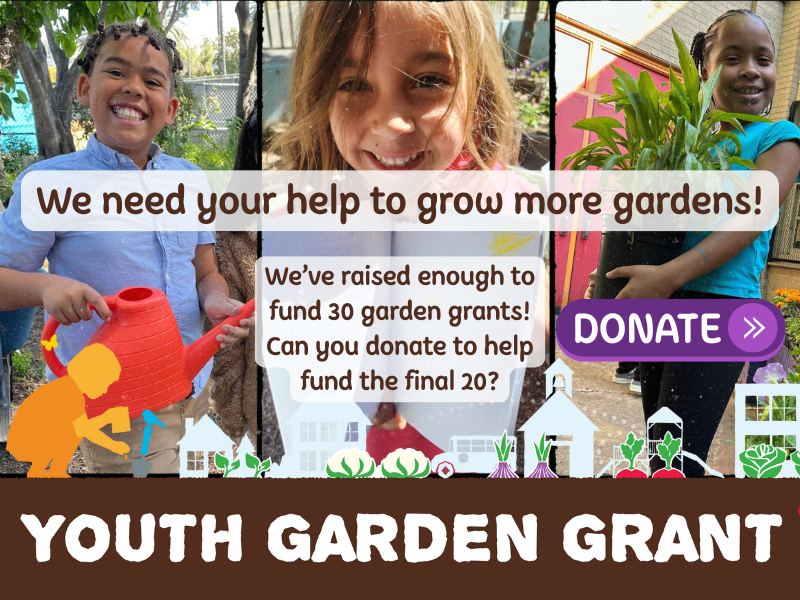Signs are often used in youth gardens as a way to creatively communicate to gardeners and visitors to pass along messages that welcome, direct, instruct, teach, and potentially warn of dangers. However, have you considered how the signage in a garden can be easily accessible to some, but effectively invisible to others?
This article explores some of the challenges your garden visitors might have in accessing the information on your signs, as well as ways to create signs that effectively communicate their message to as many garden visitors as possible.
Universal Design for Garden Signs
One way to approach signage is through the concept of "universal design." According to the Centre for Excellence in Universal Design in Dublin, Ireland,
"Universal Design is the design and composition of an environment so that it can be accessed, understood and used to the greatest extent possible by all people regardless of their age, size, ability or disability. An environment… should be designed to meet the needs of all people who wish to use it. This is not a special requirement, for the benefit of only a minority of the population. It is a fundamental condition of good design." https://universaldesign.ie/what-is-universal-design/
It may be impossible to accommodate every individual's needs. However, Universal Design invites us all to explore design solutions that make our signs accessible to as many people as possible. Challenge your young gardeners to get creative! Below you will find some practical ideas and tips for putting this advice to work in your garden.
Note: Universal Design principles are not intended to replace requirements of the Americans with Disabilities Act (ADA), which can be accessed here: https://www.ada.gov/
Barriers to Communication Via Signs
Imagine you are in a group and are hearing oohs and aahs about the lovely signs — but you are unable to enjoy them because for you the signs are inaccessible. While most of us take for granted the ability to read and enjoy signs, for others there are conditions that make this simple pleasure difficult (if not impossible), such as
- Visual impairment
- Language
- Restricted mobility
Let's look at the design challenges — and explore a few creative solutions — for each of these.
Visual Impairment/Visual Diversity
The term "visual impairment" (sometimes referred to as "visual diversity") covers a spectrum of sight-related conditions. Some people are blind, lacking any vision, while others can see blurry images. Some people have peripheral vision but lack vision in the center, while others have central vision with limited sight on the periphery.
Techniques for maximizing the visibility of signs include:
- Providing a clear line of sight to each sign; that is, be sure signs aren't hiddenby foliage, branches, or other obstructions.
- Avoiding shiny materials that reflect light, making signs difficult to read in the sun's glare. Matte surfaces are better.
- Using contrasting colors or light and dark hues to maximize visual accessibility.
- Choosing short phrases and simple fonts. Script and fancy curlicue fonts can be difficult to read, even for those without vision impairment!
- Making the text as large as possible given the dimensions of the sign. Be sure letters have adequate spacing between them.
- Displaying signs at a height and angle that accommodates visitors in both seated and standing positions.
Tactile writing allows users to trace their fingers over raised areas on a sign. Braille is an example of a tactile writing system that uses raised dots. Although this may not be possible or practical for your youth garden signage, there are other options. For example, here are some ways to create raised letters and designs:
- Draw letters with white glue or with a glue gun; as it dries/cools, it will leave raised lines that can be traced with fingers. Add glitter for texture, or paint the letters for color contrast and visual appeal.
- Bend pipe cleaners into the shapes of letters and glue them onto your sign.
- Glue fuzzy chenille yarn, garden twine, or other craft-store materials onto the sign's surface.
Color-blindness — also called "color vision deficiency" or CVD — is quite common; approximately 8% of males and .5% of females are color-blind. There are different types of CVD; most color-blind people can see colors but have difficulty distinguishing between certain colors. When choosing colors for background and text, avoid these color combinations:
- Green/red
- Brown/green
- Green/blue
In general, colors with high contrast, such as bright yellow and dark blue, will be most legible.
Language
One of the simplest ways to say "Welcome!" to garden visitors is to provide signs in their native language. Survey your young gardeners to find out what, if any, other languages they or their families speak. Is your community home to populations for which English is a second (or third!) language? Making bilingual or multilingual signs creates an inviting environment for all.
Consider using pictograms — easily recognized visual representations — on your signs. A common pictogram is a wheelchair symbol to denote areas that are wheelchair-accessible. Have kids brainstorm other pictograms that might be helpful.
Restricted Mobility
When you're designing and placing signs, remember that some garden visitors may have mobility challenges. Small signs that are close to the ground and require bending over to read will exclude those who aren't able to do so. Avoid placing signs with small or difficult-to-read text along a narrow path where visitors in wheelchairs or using walkers can't navigate. Instead, place them where they can be easily viewed.
Signs of Compassion
Help nurture compassion in your young gardeners by inviting them to imagine how they can make their gardens welcoming to all with "inclusive" signage. Challenge them to explore ways to express their creativity while ensuring no one gets left out. Remind them that they are the artists and creators of their garden signage, and, as described by Universal Design principles, inclusivity is "a fundamental condition of good design!"




